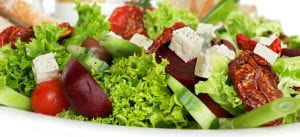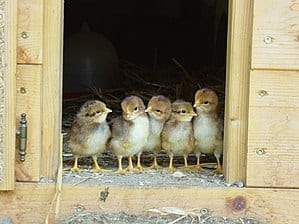The picture posed in class this week greatly encapsulates human’s relationships with animals. It shows a human-like form, that is dressed as a chef, cutting into an unidentified hunk of meat, with a few slices already carved. The way the carvings are laid out, and the fact that it is all on a cutting board, show that the meat is being sliced up and is ready to serve to people. This setup, along with the dominant stance the figure is taking, implies the dominance we as humans have over the animal species. This was shared to show the crude reality of this inter-species oppression.
When it comes to the topic of gendered food, men and women are expected to eat different things and have different eating habits. For instance, men are expected to be the ones eating meat – an idea that, Zoe Eisenberg says in her article Meat Heads – “We’ve been fed…for a decade.” (2016) She references a study where men agree that other men who have gone completely vegan, are considered “effeminate”. Women, on the other hand, are associated with things like salad, vegetables and small portions. More women, and possibly more feminists, are likely to be vegetarian or vegan. On both sides, this seems to have a basis in both marketing and societal standards. Men expect women to eat light and be in shape, which can lead to women being nervous to eat in front of men, or choosing to eat meals like salads and water.
I found an article that spoke a little more to the issue of this shift in eating norms. It seemed to begin the late 1800s, when men and women would have segregated places to eat. Paul Friedman’s article “Steak for the gentleman, salad for the lady” stated that, at the time: “Magazines and newspaper advice columns identified fish and white meat with minimal sauce, as well as new products like packaged cottage cheese, as “female foods.” And of course, there were desserts and sweets, which women, supposedly, couldn’t resist.” Anything that could be considered as light and ‘dainty’ would be considered as food for women. (Article linked below as well.)

I see this issue as relating to the way people talk about and refer to different types of women. By using the terms “chick” or “bird” to refer to them, we are reinforcing the power balance between humans and animals. These terms are used to put others in a box, and that box implies that the people within its are less than. This relates to food in the way that these names are carelessly spouted off, much like certain animals are carelessly killed for our own convenience. When women are referred to in terms of animals, they are all harmless, demure and adorable. Men are referred to as “dogs” when they date a lot of women, or other such strong animals such as bulls or horses when at work. These comparisons are complimentary for men, yet degrading for women.

Deane Curtin stated in her essay: “An ecofeminist perspective emphasizes that one’s body is oneself.” I think this simple quote explains her feelings on how ecofeminists perceive non-human animals. Animals are considered extentions of ourselves to ecofeminists. If we are harming animals, we are harming ourselves. Curtin believes that the taking of another life is inherently violent, and that violence begets violence. According to Gaard, feminists who claim a love of animals, “see a specific link between sexism and speciesism.” Her thoughts are generally in alignment with Curtin, but she goes in a slightly different direction with it. She highlights the connection between women, and the animal-specific words used to describe them (mentioned above). But according to her, eco-feminists today recognize that both between women and animals, are both being oppressed in different ways. There is an inherent understanding that speciesism is linked to many other kinds of oppression, so modern eco-feminists are invested in a world with no oppression of any kind.
Paul Friedman’s article:
https://scroll.in/article/948289/steak-for-the-gentleman-salad-for-the-lady-how-foods-came-to-be-gendered
⁸
